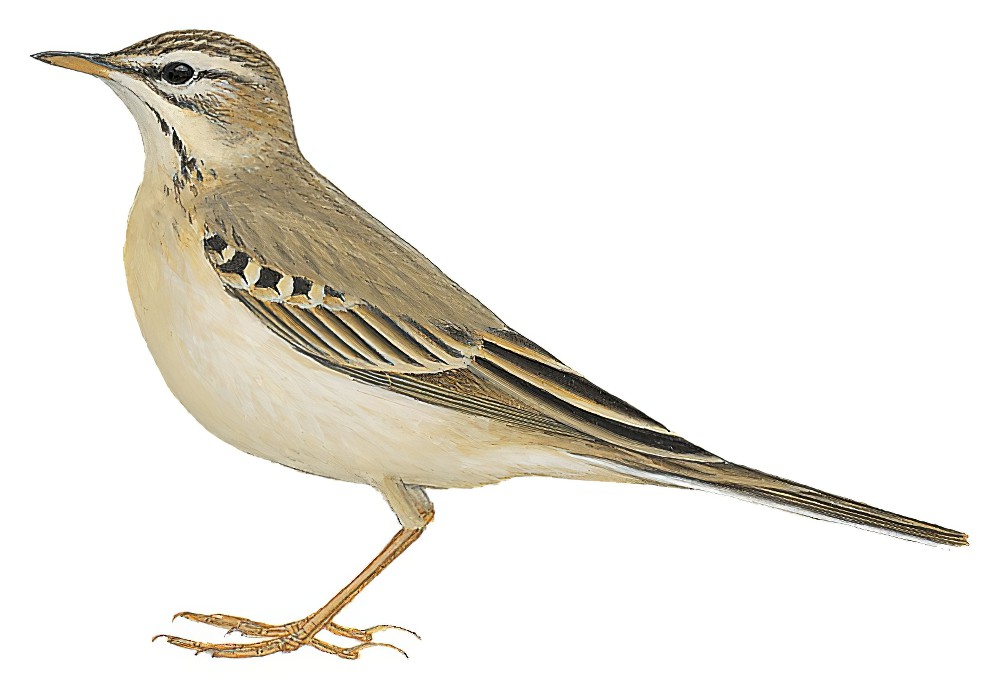Tawny Pipit / Anthus campestris

Tawny Pipit
SCI Name:
Protonym: Alauda campestris Syst.Nat.ed.10 p.166
Taxonomy: Passeriformes / Motacillidae / Anthus
Taxonomy Code: tawpip1
Type Locality: Europa = Sweden.
Author: Linnaeus
Publish Year: 1758
IUCN Status: Least Concern
DEFINITIONS
ANTHUS
(Motacillidae; † Meadow Pipit A. pratensis) L. anthus small bird that inhabited grasslands mentioned by Pliny, not further identified, but probably the Yellow Wagtail < Gr. ανθος anthos small, brightly coloured bird mentioned by Aristotle. In Gr. myth. Anthus, son of Antinous and Hippodamia, was killed by his father’s horses and metamorphosed into a bird which imitated the neighing of horses but fled at their sight; "47. Pieper. Anthus. Ich rechne zu dieser neuen Gattung vier Arten. ... Das was Frisch in der Naturgeschichte von No. III. von der Greuthlerche erzählt, gehört eigentlich zur Pieplerche (Alauda trivialis), die er Wiesenlerche nennt. Das aber, was er von der Wiesenlerche No. IV. sagt, paßt nur auf die Brachlerche (Alauda campestris). Das, was er von felner Pieplerche sagt, hat zwar seine Richtigkeit, allein die Ueberschrift ist falsch, und sollte eigentlich Wiesenlerche (Alauda pratensis) heißen *). ... *) Diese Vögel, nämlich die Brach- Piep- und Wiesenlerche haben zu vielen Irrthümern in den naturhistorischen Schriften Anlaß gegeben. Ich habe mich selbst irre führen lassen. Ich habe daher für dieselben, da sie zu auffallend von den Lerchen abweichen, eine besondere Gattung, die ich Anthus nenne, gebildet. ... 161. Die Brachlerche oder der Brachpieper. Alauda campestris. L. Taf. 15. Fig. 2. b. (Anthus campestris, mihi." (Bechstein 1805); "Anthus Bechstein, Gemein. Naturg. Deutschl. ii, pp. 247, 302, 1805. Type by subsequent designation of Mathews (Austral Av. Rec. ii, p. 123, 1918), Alauda campestris. ... This genus until recently has been quoted from Bechstein's third volume, p. 704, 1807, and the type designated by Gray in 1840 as A. spinoletta. Under the earlier citation of Anthus, here quoted, the Water-Pipit is not mentioned, so that it cannot under the Rules be designated as the type of the genus. The three species which are mentioned by Bechstein are A. campestris, A. trivialis, and A. pratensis. Sharpe, in Cat. Bds. Brit. Mus. x, p. 534, 1885, designated A. trivialis, but did not quote the earlier reference to Bechstein. Mathews subsequently therefore (Austral Av. Rec. ii, p. 123, 1918) designated A. campestris, which is here accepted as the type." (W. Sclater, 1930, Syst. Av. Aethiop., II, 340); "Anthus Bechstein, 1805, Gemein. Nat. Deutschl., 2, p. 247, 302, 465. Type, by subsequent designation, Alauda pratensis Linnaeus (Selby, 1825, Illust. Brit. Orn., p. xxix)." (Vaurie in Peters, 1960, IX, p. 144).
Var. Arthur, Artthus.
Synon. Afranthus, Agrodroma, Anomalanthana, Anomalanthus, Austranthus, Caffranthus, Cichlops, Cinaedium, Corydalla, Dendronanthus, Heterura, Leimoniptera, Meganthus, Megistina, Neocorys, Notiocorys, Oreocorys, Pediocorys, Petranthus, Pipastes, Rhabdochlamys, Seiren, Spipola, Xanthocorys.
campestris
L. campester, campestris of the fields or plains < campus, campi field.
● "93. ALAUDA. ... campestris. 4. A. rectricibus fuscis inferiori medietate, exceptis intermediis duabus, albis, gula pectoreque flavescente. Fn. svec. 193. Alauda minor campestris. Will. orn. 150. Raj. av. 70. n. 6. Habitat in Europa." (Linnaeus 1758) (Anthus).
● ex “Chorlito ribetes blancos acanelados” of de Azara 1802-1805, no. 398 (syn. Bartramia longicauda).
● ex “Gavilan del campo pardo” of de Azara 1802-1805, no. 33 (syn. Circus cinereus) (=☼).
● ex “Carpintero campestre” of de Azara 1802-1805, no. 253 (Colaptes).
● ex “American Hedge-Sparrow” of Edwards 1750 (Euneornis).
● ex “Chorlito campesino” of de Azara 1802-1805, no. 397 (syn. Numenius borealis).
● ex “Ñacundá ” of de Azara 1802-1805, no. 312 (syn. Podager nacunda).
SUBSPECIES
Tawny Pipit (campestris)
SCI Name: Anthus campestris campestris
campestris
L. campester, campestris of the fields or plains < campus, campi field.
● "93. ALAUDA. ... campestris. 4. A. rectricibus fuscis inferiori medietate, exceptis intermediis duabus, albis, gula pectoreque flavescente. Fn. svec. 193. Alauda minor campestris. Will. orn. 150. Raj. av. 70. n. 6. Habitat in Europa." (Linnaeus 1758) (Anthus).
● ex “Chorlito ribetes blancos acanelados” of de Azara 1802-1805, no. 398 (syn. Bartramia longicauda).
● ex “Gavilan del campo pardo” of de Azara 1802-1805, no. 33 (syn. Circus cinereus) (=☼).
● ex “Carpintero campestre” of de Azara 1802-1805, no. 253 (Colaptes).
● ex “American Hedge-Sparrow” of Edwards 1750 (Euneornis).
● ex “Chorlito campesino” of de Azara 1802-1805, no. 397 (syn. Numenius borealis).
● ex “Ñacundá ” of de Azara 1802-1805, no. 312 (syn. Podager nacunda).
Tawny Pipit (kastschenkoi)
SCI Name: Anthus campestris kastschenkoi
kastschenkoi
Prof. Dr Nikolai Feofanovich Kastschenko (1858-1935) Russian zoologist, explorer, collector in Siberia (syn. Anthus campestris).
Tawny Pipit (griseus)
SCI Name: Anthus campestris griseus
griseum / griseus
Med. L. griseum, griseus or grisius grey.
● ex “Crabier de Cayenne” of d’Aubenton 1765-1781, pl. 908, and “Crabier gris à tête et queue vertes” of de Buffon 1770-1783 (syn. Butorides striatus).
● ex “Brown Snipe” of Pennant 1785 (Limnodromus).
● ex “Caille brune de Madagascar” of Sonnerat 1776, and “Grey-throated Quail” of Latham 1783 (syn. Margaroperdix madagarensis).
● ex “Engoulevent gris” of de Buffon 1770-1783, and “Grey Goatsucker” of Latham 1785 (Nyctibius).
● ex “Grey Hornbill” of Latham 1787 (Ocyceros).
● ex “Manakin cendré de Cayenne” of d’Aubenton 1765-1781, pl. 687, fig. 1 (syn. Pachyramphus rufus).
● ex “Grignet” of Levaillant 1801-1804, pl. 126 (syn. Parisoma subcaeruleum).
● ex “Ara gris à trompe” of Levaillant 1801-1805 (syn. Probosciger aterrimus).
● ex “Tangara olive de la Louisiane” of d’Aubenton 1765-1781, pl. 714, fig. 1, and “Gris-Olive” of de Buffon 1770-1785 (Vireo).
● ex “Icterus cinereus Novae Hispaniae” of Brisson 1760, “Tocolin” of de Buffon 1770-1783, and “Grey Oriole” of Latham 1782 (unident.).
UPPERCASE: current genus
Uppercase first letter: generic synonym
● and ● See: generic homonyms
lowercase: species and subspecies
●: early names, variants, mispellings
‡: extinct
†: type species
Gr.: ancient Greek
L.: Latin
<: derived from
syn: synonym of
/: separates historical and modern geographic names
ex: based on
TL: type locality
OD: original diagnosis (genus) or original description (species)












